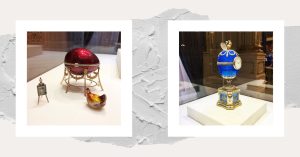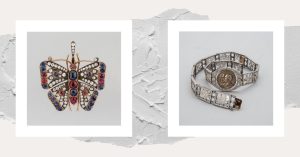Today people know the name Fabergé in connection to the amazing collection of imperial jewelry easter eggs. But there is a long story behind it. Carl Fabergé believed that the beauty of every jewelry isn’t in the material it is done from. The beauty of jewelry is in the art of the work, into the ability to see the world different, special. The jeweler must be the artist! That was the philosophy of Carl Fabergé.
Let’s look at his story!

The father of Carl, Gustav Fabergé (1814-1893), the descendant of French Huguenot craftsmen, opened a small jewelry firm and workshop in St. Petersburg in 1842, after an apprenticeship in St. Petersburg,
Gustav’s eldest son, Carl, better known today simply as Fabergé, was born in 1846. He was schooled first in St. Petersburg and then, after his father’s retirement in 1860, in Dresden. An educational Grand Tour of Europe in the mid-1860s considerably broadened his education, allowing him, on his return, to join his father’s business.
Beginning in 1869, after returning from his Grand Tour, Fabergé wisely ingratiated himself with the powerful Imperial Cabinet. He offered his services free of charge, appraising and restoring jewelry and objects of art in the treasury of the Hermitage Museum. This Imperial Cabinet was responsible for administering the crown jewels and the contents of the treasury as well as controlling the commission of presentation gifts. Such a connection was thus of capital importance to the career of any aspiring jeweler. By 1872 he was able to take over the reins of his father’s business.
The firm experienced a breakthrough in 1882 with major success at the All-Russian Industrial and Art Exhibition in Moscow, where Empress Maria Feodorovna acquired a small piece of archaeological jewelry. After sixteen years of service, Fabergé applied, in 1884, for the position of Supplier to the Imperial Court. Initially rejected, he was granted the title in 1885.

The story of Carl Faberge is the story of a remarkable man who, together with his brother Agathon (1862-1895) and four sons, Eugène (1874-1960), Agathon (1876-1951), Alexander (1877-1952), and Nicholas (1884-1939), transformed his father’s small jewelry firm into Russia’s largest enterprise of its kind. With over five hundred employees, the firmis said to have produced more than three hundred thousand objects of art, jewels, and silver articles – most of them one of a kind and each a work of exquisite design and craftsmanship. No creation by the hand of this Russian master seems to have survived. Yet the large majority of the objects made in St. Petersburg are unmistakably imbued with his personality. His highly original choice of objects and his supervision of their design, style, and perfect execution marked them as creations of Fabergé. The popular image of the jeweller-hammer in hand, meticulously examining every single article and mercilessly smashing any imperfect object – is surely apocryphal, but it speaks to his demand for excellence. Unless flawless in every respect, pieces were sent back to the workbench.
Faberge had the following tenets:
1) every object produced had to be in perfect condition (even if parts were prefabricated, the piece was exactingly finished by hand);
2) pieces were to be unique and of the latest fashion, and unsold goods destroyed every year so that visitors would always find enchanting new objects for sale;
3) objects were not excessively “marked up” but priced according to their true value; prices were kept attractively low, aided in part by the frequent use of materials of small intrinsic value – wood, lacquer, leather, cork, and hardstones of local origin;
4) the assortment was always vast, so as to offer something to please each customer.

Widely recognized in Russia, Fabergé opened branches in Moscow (1887) and acquired premises in St. Petersburg (1898-1900), as well as opened further branches in Odessa (1901) and Kiev (1906). Aside from four branch offices at home, Fabergé was also ahead of most of his local competitors in prospecting a new clientele abroad. His London branch, opened in 1903, catered to many of the royal houses of Europe, the nobility, the demi-monde, and the newly rich including bankers and the many Americans who arrived in London for the season. The firm’s London sales ledgers from 1907 to 1917 are a veritable register of elegant society.
Beginning in 1909 Fabergé also sent teams of sales people to Paris, the Côte d’Azur, and Rome. With the exception of the firm of Cartier, no jeweler had been farsighted enough at the time to look to the Far East as a potential source of business. Financed by his London office, Fabergé sent sales teams twice a year to Siam (now Thailand) and to the maharajas of India. He was invited to Siam in 1904 by King Chulalongkorn (Rama V) and was instrumental in building up a collection of beautiful Siberian jade works and objects of still kept in the royal palace in Bangkok. Fabergé’s objects were sent by the Emperor as diplomatic presents to the Ottoman Empire, countries of the Arabian Peninsula, China, and Japan.
Highlights marking Fabergé’s exceptional career include the 1896 coronation ceremonies, for which he supplied many of the finest jeweled gifts; the 1903 Imperial Costume Ball and its jewels, which he created for Empress Alexandra Feodorovna, wife of Emperor Nicholas II, and no doubt for many other members of the court; and the 1913 Romanov Tercentenary celebration, which, with its large number of orders, was the culminating and last major event of Romanov rule.

By 1914 Russia had entered World War I, and many of Fabergé’s craftsmen were enlisted. For lack of gold, platinum, and silver, and despite many outstanding Imperial orders, the firm was obliged to produce objects in base metals as well as hand grenades. Fabergé, forestalling the ominous end, converted the business into a joint stockholding company in 1916 and formed a Committee of the Employees of the C. Fabergé Company the following year. Finally, in 1918, he fled, handing the keys of his premises to a member of the city’s Hermitage Museum.
Within forty years of its humble beginnings, Carl Fabergé’s firm had eclipsed all local competition, acquiring world fame.
The great craftsman died in 1920 in Switzerland as a brokenhearted refugee.
How did you like the post? SURVEY
________________________________________________________________________________
More inspiration you can find in my Instagram @atlas_of_inspiration
________________________________________________________________________________
All posts:
Sharing Inspiration. Introduction
Sharing Inspiration. The World of Fabergé. Part 2
Sharing Inspiration. The World of Fabergé. Part 3
Sharing Inspiration. The World of Fabergé. Part 4
Sharing Inspiration. The World of Fabergé. Part 5
Sharing Inspiration. The World of Fabergé. Part 6
Sharing Inspiration. Russian Ballet. Part 1
Sharing Inspiration. Russian Ballet. Part 2
Sharing Inspiration. Russian Ballet. Part 3
Sharing Inspiration. Russian Ballet. Part 4
Sharing Inspiration. Russian Ballet. Part 5
Sharing Inspiration. Cultural Diversity. Part 1
Sharing Inspiration. Cultural Diversity. Part 2
Sharing Inspiration. Cultural Diversity. Part 3
Sharing Inspiration. Cultural Diversity. Part 4
Sharing Inspiration. Cultural Diversity. Part 5
________________________________________________________________________________
Sources:
G. von Habsburg, T. Muntian, V. Skurlov, U. Tillander-Godenhielm, K. McCarthy, M. Schaffer, I. Buseva-Davydova, A. von Solodkoff, E. Khmelnitskaya. “Faberge. Treausures of Imperial Russia. Faberge Museum, St. Petersburg”, New York: Skira Rizzoli, 2017.



